
Yellowjacket or yellow jacket is the common name in North America for predatory social wasps of the genera Vespula and Dolichovespula. Members of these genera are known simply as "wasps" in other English-speaking countries. Most of these are black and yellow like the eastern yellowjacket Vespula maculifrons and the aerial yellowjacket Dolichovespula arenaria; some are black and white like the bald-faced hornet, Dolichovespula maculata. Others may have the abdomen background color red instead of black. They can be identified by their distinctive markings, their occurrence only in colonies, and a characteristic, rapid, side-to-side flight pattern prior to landing. All females are capable of stinging. Yellowjackets are important predators of pest insects.

The spinach is a moth of the family Geometridae. The species was first described by Johan Christian Fabricius in 1787. It is found throughout much of the Palearctic region and the Near East though its distribution is rather local due to its specialized larval food plant. In the British Isles it is fairly common in England and Wales but much rarer in Scotland and Ireland.
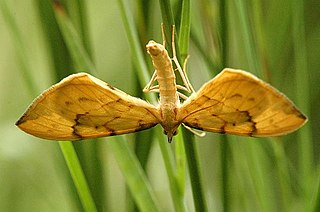
The barred straw is a moth of the family Geometridae. The species was first described by Michael Denis and Ignaz Schiffermüller in 1775. It is sometimes placed in the genus Gandaritis. It is found throughout the Palearctic region, including Britain and Ireland, and also the Near East.
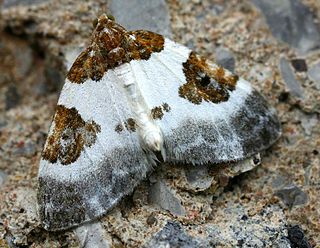
The Cidariini are the largest tribe of geometer moths in the subfamily Larentiinae. The Cidariini include many of the species known as "carpets" or, ambiguously, "carpet moths", and are among the few geometer moths that have been subject to fairly comprehensive cladistic study of their phylogeny. The tribe was described by Philogène Auguste Joseph Duponchel in 1845.

Physocarpus opulifolius, known as common ninebark, Eastern ninebark, Atlantic ninebark, or simply ninebark, is a species of flowering plant in the rose family Rosaceae, native to eastern North America.

Syntelia is a genus of beetles. It is the only genus in the family Synteliidae. There are seven known species, which are native to high-elevation regions in southern North America from central Mexico to Guatemala, and in eastern Asia, from India to Japan and eastern Russia. They are generally associated with rotting logs, typically found under bark, thought the Mexican species S. westwoodi has been found inside large decaying columnar cacti. Adults and larvae are predatory, feeding on insect larvae. A fossil species, Syntelia sunwukong, is known from the Late Cretaceous (Cenomanian) aged Burmese amber of Myanmar. Adults are around 1–3.5 centimetres (0.39–1.38 in) in length. The characteristics of the family and genus include geniculate antennae with 3-segmented club, elongate body, narrowly separated coxae and tarsi with bisetose empodia. Only one abdominal segment is exposed behind elytra. The genus described by John O. Westwood in 1864, while the family was erected by George Lewis in 1882. They are members of Histeroidea, which also includes clown beetles (Histeridae).
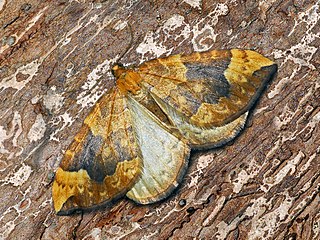
Eulithis populata, the northern spinach, is a moth of the genus Eulithis in the family Geometridae.

Eulithis prunata, the phoenix, is a moth of the genus Eulithis in the family Geometridae.

Ecliptopera silaceata, the small phoenix, is a moth of the family Geometridae. The species was first described by Michael Denis and Ignaz Schiffermüller in 1775.

Eulithis is a Holarctic genus of moths in the family Geometridae erected by Jacob Hübner in 1821.
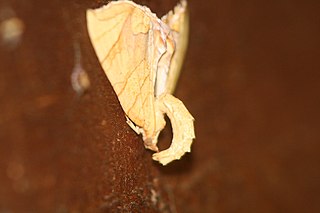
Eulithis gracilineata, the greater grapevine looper, is a moth of the family Geometridae. The species was first described by Achille Guenée in 1858. It is found from eastern Canada south to Florida. It has also been collected west to Saskatchewan and central Alberta, where it is rare.

Eulithis testata, the chevron, is a moth of the family Geometridae. The species was first described by Carl Linnaeus in 1761. It is found in both the Palearctic and the Nearctic realms. In the Palearctic it ranges from Great Britain and Scandinavia, south to the Alps, east through Russia and the Russian Far East to Japan. In North America, it is found from Newfoundland to Vancouver Island and Alaska, south in the east to about New Jersey and in the west to Colorado.
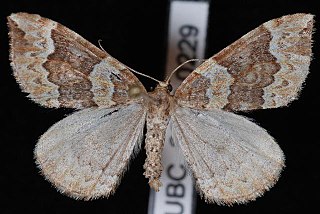
Eulithis destinata is a species of geometrid moth in the family Geometridae. It is found in North America.
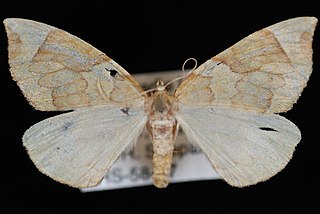
Eulithis propulsata, known generally as the barred yellow or currant eulithis moth, is a species of geometrid moth in the family Geometridae. It is found in North America.
Eulithis molliculata, the dimorphic eulithis, is a species of geometrid moth in the family Geometridae. It is found in North America.
Eulithis explanata, the white eulithis, is a species of geometrid moth in the family Geometridae. It is found in North America.
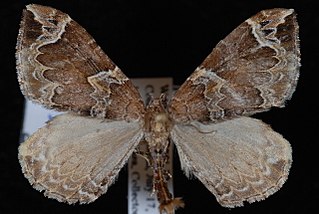
Eulithis xylina, the northwestern phoenix moth, is a species of geometrid moth in the family Geometridae. It is found in North America.

Eulithis luteolata is a species of geometrid moth in the family Geometridae. It is found in North America.
Eulithis serrataria, the serrated eulithis, is a species of moth in the family Geometridae. It was first described by William Barnes and James Halliday McDunnough in 1917 and it is found in North America.















